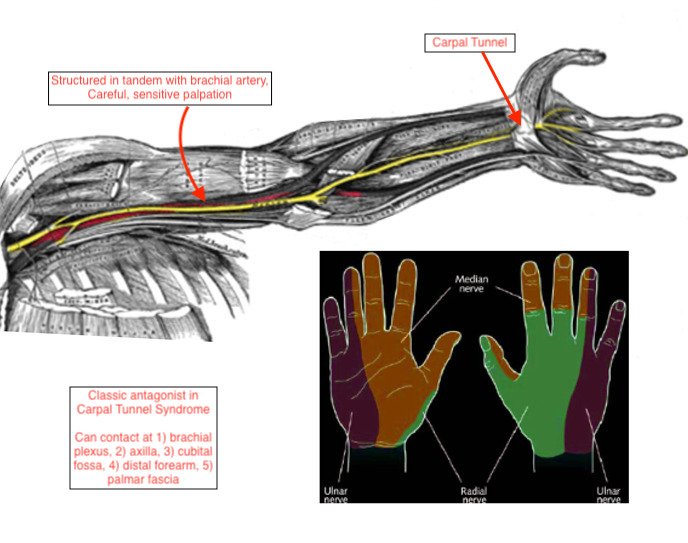Massage Therapy Benefits: Pain
An Outline of Pain Reduction Associated with Some Common Conditions
If you’re curious about the positive effects that massage therapy can have, then join the club. When I first experienced massage therapy as a client, I wondered about the positive effects that it might have for certain populations — people, like me, who experience pain as a result of overuse and physical stress. Now as a practitioner, I have been able to narrow in on what populations might benefit from receiving massage. My hope in this article is to briefly share some of the common conditions people might seek massage therapy for, and to share some sources in literature for how effective massage might be for pain relief. I’ll also add in some information from my clinical experience to actualize what might be happening under the hood.
Neuromuscular Pain
People often seek out massage therapy when they are experiencing neuromuscular pain. For some people, neuromuscular pain is often a byproduct of everyday life. Some of us live very repetitively, utilizing the same muscle groups in coordination to accomplish a task. Our bodies are terrific at adapting to stress, but sometimes repetitive movement over the span of years or decades can lead to a body becoming “fixed” in a certain posture or pattern. This repetitive strain is often what causes pain. In my practice, I often think of pain not only as an experience, but also a type of evolutionarily wired warning light that lets us know that we should change our habits before something more destructive and permanent occurs. We can of course choose to heed the warning, or blatantly ignore it.
A 2016 study published in Pain Medicine that analyzed 67 studies on the impact of massage on pain conditions concluded that “There is clear evidence supporting the efficacy of massage therapy compared to no treatment for pain intensity suggesting that massage therapy, rather than no treatment at all, should be offered to a patient for pain management.” This is clear to suggest that massage therapy is effective when compared to seeking no other treatment options. Pain management is an appealing reason why massage therapists are often referred to from medical doctors and other health care providers.
A Note: Holistic Treatment
When pain emerges from a neuromuscular condition, it is usually not just a nerve + muscle condition. There are numerous other factors that come into play including: emotional state, posture, health history, perception of pain, and belief structure. In my practice, I am continuously growing more attuned to the infinite complexities that govern our bodies. There isn’t just one button we can press to “solve a problem.” We instead must work within a context of what is most helpful in decreasing indicators such as pain, while drawing awareness to the other systems involved in your present experience. Sometimes a diagnosed condition can be more of a hindrance than an undiagnosed one. This is something I will explore in a later article on our belief structures, and the role they have in therapeutic interactions.
Conditions
It is not within my scope of practice to diagnose conditions, so many clients come with an already named condition from another medical provider. Some common conditions I treat every week are sciatica, carpal tunnel syndrome, and TMJ syndrome (just to name a few). I hope the following information is helpful.
Sciatica is often described as a burning, numbness, or tingling in the back of the leg, with the sensations translating throughout the lower back, buttocks, and lower leg. It can cause uncomfortable and painful experiences in various movements, which relates back to the sciatic nerve. The sciatic nerve can be impinged at numerous anatomical landmarks in many possible ways, making the condition relatively difficult to treat. However, working in and around the piriformis muscle, and desensitizing the nerve as it passes through the upper leg, are usually helpful paths to decreasing pain. The exact physical remedy will always be unique to the client.
Image: Gray’s Anatomy Slides
Carpal tunnel syndrome is usually caused by an impingement of the median nerve, which is one of the collection of nerves, arteries, and veins that pass through the carpal tunnel in the wrist. The carpal tunnel can become narrower over time, through repetitive activity, and cause compression of the median nerve, resulting in pain and discomfort throughout the arm up to the shoulder. The median nerve can also be impinged anywhere along its pathway, so it is usually helpful to explore and address the whole arm-shoulder-neck complex, along with how the body functions through some sort of meaningful movement.
Image: Gray’s Anatomy Slides [Red Text Added by Me]
TMJ syndrome is often a result of whiplash injury, emotional stress, jaw clenching, and/or trigeminal nerve impingement. The array of causes could be all of these or none of them, depending on the individual. It is usually the case that whatever is under the surface emotionally tends to connect to what is happening physically in the jaw and surrounding areas. I have found that bringing awareness to the jaw through manual release can sometimes be enough to show the body that there is another, more habitable, state of experience out there. Releasing the jaw and addressing the trigeminal nerve at different access points can also be helpful. Clicking sounds and the feeling of an unbalanced jaw that is usually associated with TMJ syndrome can be balanced out by routine manual therapy. When TMJ syndrome is very complex, massage therapy can be an integral part of an extensive care network to return an individual to a better state of experience.
Thank you for reading.

